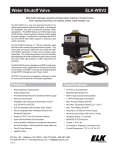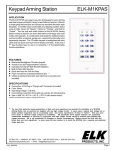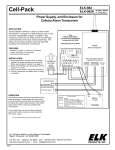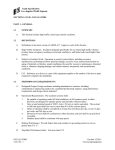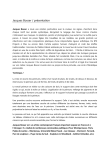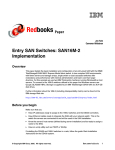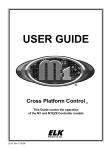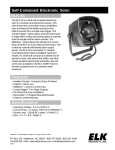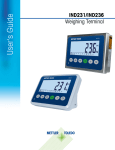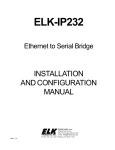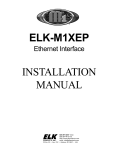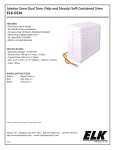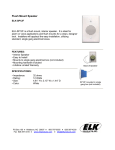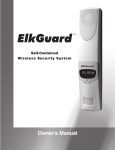Download Elk Battery LifeTester -BLT User's Manual
Transcript
Battery LifeTester ELK-BLT v.2 Mhos Meter The NEW and improved ELK-BLT v.2 Battery LifeTester is a compact, easy to use Mhos Meter for testing 12 Volt rechargeable batteries. Unlike ordinary testers which only measure static criteria, the LifeTester measures internal conductivity, which is the best indicator of a battery’s health and life expectancy. The conductivity value, expressed in Mhos (the inverse of Ohms or resistance), is easily compared to benchmark readings from the included Mhos Chart. The chart then categorizes the battery condition as “Best, Good, Weak, or Bad”. Every battery type has a characteristic Mhos value when it is brand new and fully charged. The LifeTester is powered by the battery under test and automatically warns when the battery voltage is too low for testing. Features • • • • • • • • Does not discharge or damage the battery. Tests 12 Volt Rechargeable Batteries. Display Shows Battery Voltage and Mhos. Warns if battery voltage is too low. Replaceable test leads. Includes padded carrying case. Includes self-adhesive test data labels. ** Lifetime Limited Warranty. Specifications • • • • Operating Voltage: 10.0V - 14 Volts D.C. Current Draw: 1.1 Amps Max., 0.0016 Ah for full test. Battery Leads: ~12 Inches. Size: 4.4” W x 3”H x 1.15”D w/o carrying case. ** To reorder a pack of 100 test data labels specify: ELK-BLT LABELS. PO Box 100 • Hildebran, NC 28637 • 800-797-9355 • 828-397-4200 Fax 828-397-4415 • www.elkproducts.com • [email protected] 05/04 ELK PRODUCTS, INC. ELK - BLT Instructions 1. Disconnect the battery from it’s equipment. 2. Connect the BLACK test clip to the Negative (-) battery terminal, and the RED to the Positive (+) terminal. (For accurate readings, the test clips must be tightly clipped directly to the battery posts, not to the battery bolts). “Err” or blank indicates battery voltage is too low for testing or a test clip connection is loose. Try charging the battery or reconnecting the test clips. 3. The Voltage of the Battery will display briefly. A new battery, out of the box, will generally read around 12.6 Volts. A fullycharged battery should read between 12.6 Volts and 13.5 Volts. “- - -” indicates test in process, please wait. 4. The Mhos (internal conductance) reading of the battery will display within 6 seconds. 5. Refer to the Mhos Chart. In the Ah column, find the battery size. Follow across the row to find the closest match to it’s Mhos reading. The column heading and color code indicates the test results. NOTE: The Mhos chart printed on the BLT is best suited for batteries under charge and at room temperatures of around 72F degrees. This covers most batteries, even in cold basements or buildings, since the battery will be kept warm by the recharging and by being inside the electronics enclosure. However, since cooler temperatures can significantly lower the Mhos reading of a battery, this instruction manual has a more extensive Mhos chart with columns for evaluating batteries that are being adversely affected by 62F, 52F, and 42F degree environments. Also see How Temperature affects a Battery 6. For future reference mark the battery with the Voltage, Mhos reading, and test date. Automatic Shutdown If the LifeTester is left connected to a battery for more than 30 seconds after the test is complete, it will automatically shutdown to conserve battery power. Disconnecting and reconnecting a test lead will restart the test procedure. Recording Battery Readings LifeTester measurements should be taken and recorded periodically. The popular method is to record the information onto selfadhesive labels placed directly onto the battery. A supply of these labels is included with the tester. Additional labels may be ordered in packs of 100 by specifying part number ELK-BLT LABELS. This information will be valuable in future tests for trending analysis. The recorded data should include: A. The Date of the test. B. The Battery Voltage reading. (optional) C. The Mhos reading. A new “fresh out of the box” battery that has not been charged should have a Mhos value in the high side of the Good column and quite possibly into the Best column. See the Mhos chart. If the reading is considerably lower, charge the battery for at least 24 hours and then retest. Battery performance degrades over time due to use and abuse, and may be impacted by many factors like depth and frequency of discharge. The higher the Mhos value the more current the battery can deliver. Therefore, a new 7 amp-hour battery will have a higher Mhos value than a new 4 amp-hour battery of the similar construction. ELK - BLT Instructions How Temperature affects a Battery Generally speaking, temperatures below 72F degrees tend to slow down a battery’s internal activity, causing a significant decrease in the Mhos (conductivity) reading as the temperature falls. Cool temperatures (not below freezing) will tend to prolong a battery’s life. Temperatures above 72F cause a battery’s internal activity to accelerate, but with only a slight increase in the Mhos reading. Warm temperatures will tend to dry out and degrade a battery much faster than normal. 100 F degrees = 105 % of normal Mhos (conductivity) 72 F degrees = 0 % no adjustment 62 F degrees = 92 % of normal Mhos (conductivity) 52 F degrees = 87 % of normal Mhos (conductivity) 42 F degrees = 82 % of normal Mhos (conductivity) 32 F degrees = 76 % of normal Mhos (conductivity) ELK Products is not responsible for misprints or errors. These Mhos values are benchmark averages, created from fresh samples of major brand batteries. If you find consistent, minor variations in readings from multiple samples of a battery, it’s likely due to manufacturing differences. However, if the readings are excessively low, the battery is not as good as the benchmark average. If this chart does not include the battery you are testing, it may be necessary to generate the values using the procedure below. Adding to the Battery Mhos Chart If the battery you are trying to test is not included in the Battery Mhos Chart it may be necessary to research and generate the data on your own. The following procedure will help with this task. Start with 2 or 3 fresh new batteries out of the box. The battery voltage should be around 12.6 Volts or higher. Place the batteries in service (on charge) for 24 hours. Remove them from charge and measure the Mhos reading of each one. Average the readings together. This will be the baseline number from which the Best, Good, Weak, and Bad columns are calculated. The “Best” column will be 90% of the baseline number. The first and second numbers in the “Good” column are 80% and 89% of the baseline. The first and second numbers in the “Weak” column are 70% and 79% of the baseline. The “Bad” column is 0% and 69% of the baseline. ELK - BLT Instructions Accumulating Trend Analysis over a Period of Years Trending of periodic Mhos measurements can yield valuable insights for estimating the remaining life of the battery. Suppose that a 4.0 Ah battery has been in service for three years and that the LifeTester measurements after the first year was 90 Mhos, 85 Mhos after the second year, and 80 Mhos after the third year. Since the battery is still at 80 Mhos and is dropping an average of 5 Mhos per year, it is highly likely that this battery will not need replacing before the end of the fourth year. On the other hand, suppose that the readings were 90 Mhos after the first year, 82 Mhos after the second year, and 70 Mhos after the third year. The rate of decay has increased from 8 Mhos to 12 Mhos per year. This indicates that although the battery is still serviceable, it is degrading more and more rapidly. It is unlikely that this battery will be serviceable for another year. Under these circumstances, either the battery should be replaced early or the service interval should be shortened to catch this battery before a system failure. Why Mhos instead of Amp Hour The LifeTester measures the Mhos (conductance) of a battery using an AC impedance measurement algorithm. Every battery manufacturing process produces a slightly different conductance value for a given battery size. Elk Products elected to display consistent, accurate Mhos (conductance) values, rather than just estimated Amp Hour values. The only accurate method for measuring a battery’s Amp-hour capacity is with a long discharge test, which actually decreases the life of the battery. Estimation of Amp-hour capacity without a discharge test is a complex error-prone process involving the conductance value, the battery stateof-charge, the voltage, the temperature, and the many varying design and production variables for each battery type. Ordinary testers which measure static criteria or Amp-hour are inherently inaccurate across varying battery designs. In contrast, extensive testing has proven that when the conductance of a charged battery is tested and has declined to approximately 70% of its fullcapacity reference, the battery is unlikely to deliver its rated capacity and should be replaced. Is Mhos relational to Cold Cranking Amp The LifeTester is designed to measure the conductance of a battery at frequencies indicative of the capacity of a battery in Amphour. Conductance measurements for estimating the Cold Cranking Amps for starter type batteries are at a much higher frequency. Although the measurement techniques are similar, there is little correlation between the Cold Cranking Amps measurement of a battery and the Mhos reading of the LifeTester, or vice-versa. Using Mhos to Estimate Battery Life The Mhos reading of a new battery out of the box, will generally not be the same as that of a fully charged battery. This is due to the plates not being totally formed during manufacturing. Once the battery has been on charge for some time the plates will finish forming and the peak Mhos reading will normalize. For standby batteries, peak capacity is normally reached after about three months on a float charging system. For cyclic use batteries, full capacity may not be reached until after ten to thirty cycles, depending upon the depth of discharge and the charging method. If a new battery has been in storage for an extended period, say over six months without being charged, plate oxidation from selfdischarge will occur, causing a decrease in the Mhos reading. Plate oxidation also occurs in standby batteries during a power failure, particularly if a battery remains in a highly discharged state for an extended time period. Plate oxidation is unhealthy and can destroy a battery’s capacity. Once a battery is weakened by plate oxidation, it is difficult to recover full capacity without special charging or conditioning methods. In some cases a battery will recover and pass a test after being recharged. However, a second test should be performed a few days later after recovery to accurately assess the overall life of the battery. The average life cycle of a sealed lead-acid battery in standby use on a float charge is 3 to 5 years. A battery with a Mhos reading of less than 70% of its original capacity is no longer considered serviceable and should be replaced.





